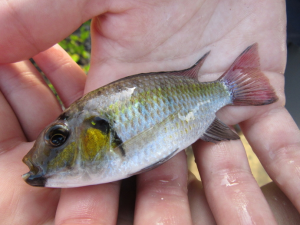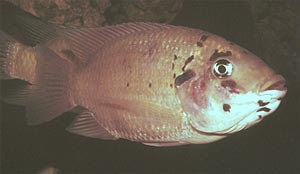Blackchin Tilapia
Blackchin Tilapia (Sarotherodon melanotheron)
Description:
- Usually have black spots on chin or throat (Campbell 1987)
- Irregular vertical bars (Trewavas 1983)
- Gold spot near gills in males (Trewavas 1983)
Habitat:
- High salinity tolerance (Randall 1987) and prefers brackish water (Trewavas 1983)
- Found in streams, estuaries and wetlands (Englund 2005)
Impacts & Concern:
- Can greatly reduce aquatic vegetation present (Courtenay 1974) and therefore negatively impact native Hawaiian birds (McGuire 2006)
- May overcrowd (Courtenay 1974) or act aggressive towards native fish (Faunce and Paperno 1999)
- Could serve as a vector of disease: blackchin tilapia is impacted by an unknown disease sometimes with no symptoms (Mauel et al. 2003) as well as the bacterium Francisella noatunensis subsp. Orientalis (Yamasaki et al. 2022)
Introduction:
- Imported by Bureau of Commercial Fisheries in 1962 onto Sand Island where it was studied as potential tuna bait and likely escaped (Randall 1987)
- After initial escape, blackchin tilapia spread through freshwater and estuary habitats (Szyper et al. 2000)
Distribution in Hawaii:
- Kauai: Anahola Stream, Puali Stream (Yamasaki 2022)
- Oʻahu: Kahuku Pond, Kuliouou Steam, Kawaihāpai Reservoir (Yamasaki 2022), Wahiawa Lake, Nuʻuana Reservoir (Wu and Yang 2012)
- Molokai: Not documented
- Lanai: Not documented
- Maui: Not documented
- Big Island: Not documented
Related AIS Team Management Projects:
- 2019 Special Activity Permit allowed DAR officials and local fishermen to net about 300 fish in Nu‘alolo Bay, Kaua‘i
- DAR investigated a large die-off of tilapia in the ‘Anahulu River near Hale‘iwa, O‘ahu after reports from kayak/SUP rental companies
- Monitoring for spread and disease outbreaks continues
Regulations:
- Prohibited for import, not currently listed under HDOA import rules (§4-71-6.5)
References:
- Campbell, D. (1987). A review of the culture of Sarotherodon melanotheron in West Africa. UNDP-FAO-NIOMR. 20 p.
- Courtenay W.R., Sahlman H. F., Miley W. M., Herrema D. J. Exotic fishes in fresh and brackish waters of Florida. (1974). Biological Conservation, 6(4), 292-302. https://doi.org/10.1016/0006-3207(74)90008-1
- Englund, R.A. (2005). Threats to native aquatic insect biodiversity in Hawaiʻi and the Pacific, and challenges in their conservation. [Doctoral dissertation, University of Hawaiʻi]. University of Hawaiʻi Manoa ScholarSpace.
- Faunce, C.H. & Paperno R. (1999). Tilapia-dominated fish assemblages within an impounded mangrove ecosystem in east-central Florida. Wetlands, 19(1), 126-138.
- Mauel, M., Miller, D., Frazier, K., Liggett, A., & Styer, L., Montgomery-Brock, D., & Brock, J. (2003). Characterization of a piscirickettsiosis-like disease in Hawaiian tilapia. Diseases of aquatic organisms, 53, 249-55. 10.3354/dao053249
- McGuire, C. (2006). Effects of introduced fish on aquatic insect abundance: A case study of Hamakua marsh, Oahu Hawaiʻi. [Master dissertation, University of Hawaiʻi]. University of Hawaiʻi Manoa ScholarSpace.
- Randall, J. E. (1987). Introductions of marine fishes to the Hawaiian Islands. Bulletin of Marine Science, 41(2), 490-502.
- Szyper, J.P., Hopkins, K.D., Malchow, W., & Okamura, W. Y. (2000). History and Prospects of Tilapia Stocks in Hawaii, U.S.A. In Tilapia Culture in the 21st Century–Proceedings from the Fifth International Symposium on Tilapia Aquaculture, Rio de Janeiro, Brazil.
- Trewavas, E. (1983). Tilapiine Fishes of the genera Sarotherodon, Oreochromis, and Danakilia. The Dorset Press. https://doi.org/10.5962/bhl.title.123198
- Yamasaki L.S., Iwai T.,Klinger-Bowen R. C., Weese D.A., Fowler C.E., Yacoub J.L., & Wong M.A. (2022). Identification of Nile tilapia (Oreochromis niloticus) and its hybrids in natural environments in Hawaii. Aquaculture, 550, e737805. https://doi.org/10.1016/j.aquaculture.2021.737805


